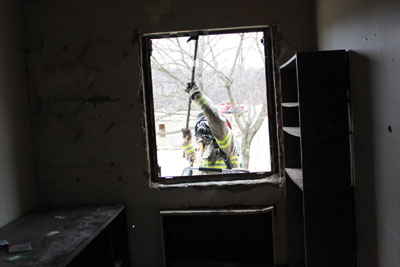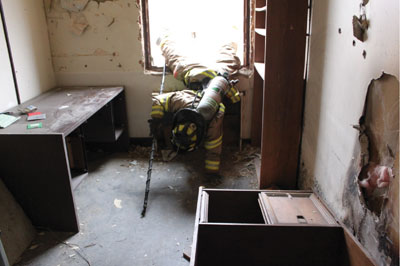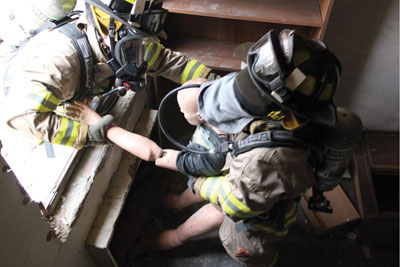
Features
Structural
Training
Back to Basics: November 2011
In the last couple of issues we looked at ventilation. One tactic for quick ventilation of structures is vent, enter and search, or VES.
November 14, 2011
By Mark van der Feyst
In the last couple of issues we looked at ventilation. One tactic for quick ventilation of structures is vent, enter and search, or VES. Unlike positive-pressure attack with positive-pressure fans (Back to Basics, June 2011), which is a fairly new innovation, VES has been around for at least 20 years. VES was developed and proven by the FDNY, but has become popular only in the last five years. VES is a successful method of efficiently ventilating a portion of a structure to quickly search for victims, as was proven on camera on May 7, 2002, in Fairborn, Ohio. On that day, firefighter Bob Swick and Deputy Chief Scott Lewis rescued baby Chelsea from her bedroom using VES. The video, which is very emotional and intense, shows Swick entering the room via a ground ladder (ventilating the room) and emerging moments later with baby Chelsea. The infant was treated and released from hospital a week later.
 |
|
| Photo 1: Breaking and venting the window is the first step of VES and allows all of the smoke and hot gases to leave the room. Photos by Mark van der Feyst |
VES is practised primarily by truck companies that arrive first on the scene. If you do not have truck companies in your fire department, first-arriving units can practise VES with two firefighters, a ground ladder and hand tools. VES is used mostly for rescues from residential buildings – either one or two storeys – but can be adapted for multiple-storey buildings, such as condominiums.
VES is a good way to rapidly enter a room, do a quick search for life, get out and move on to the next room if necessary. VES is not a primary search of a structure; it is confined to one room and one room only. The risk with VES is that there is no hoseline accompanying the firefighters who make entry. Because of this, newer firefighters are not prime candidates for VES tactics. VES is reserved for senior, experienced firefighters who have the ability to read the building and the fire conditions, know building construction and understand fire behaviour. VES works well when firefighters know there are viable victims inside the structure. This viability factor rests on a few key points, such as:
- Witness reports from family members or neighbours – Either the family members or neighbours were inside with the trapped individuals, or they saw the fire start, and can identify the exact location of a person left inside.
- Fire conditions – Conditions will indicate whether victims can survive.
- Time of day – The time of the fire can help firefighters determine whether there are potential victims inside.
- Occupancy type – The type of structure – a single-family home or a duplex, for example – will help firefighters determine the approximate number of people inside.
 |
|
| Photo 2: After checking the floor area below the window, the firefighter should enter, using the rook or pike pole to stay low to the ground. Advertisement
|
At least two firefighters – but no more than three – are needed for VES, along with a ground ladder (for second-storey window access), a flashlight, a radio, a roof hook or pike pole (five to six feet long) and a Halligan. Having more than three firefighters involved in this process can cause confusion, but a team of four firefighters could become two teams of two and could be more effective by searching two rooms at once.
The first step in VES is to break and vent the window (see photo 1). This can be done with the tip of the ladder, or by climbing up and breaking the window with hand tools. This allows all of the hot gases and smoke to vent through the window. The time period for this first step varies. Using the ladder tip to break the window takes longer than using hand tools, because the firefighter will be at the base of the ladder breaking the window, donning the SCBA facepiece and going on air, then climbing up with the hand tools to make entry. The time it takes to don the SCBA facepiece dictates how much time there will be for venting. If firefighters choose to be on the ladder and break the window with hand tools, they will have to wait a few moments to allow for ventilation. Some instructors teach students to don the SCBA facepiece at this point while waiting to make entry. This allows sufficient time for ventilation to occur.
The second step is to enter into the room. First, firefighters need to sweep the area immediately below the window. A sweeping motion is encouraged rather than pounding the floor, because the victim could be on the floor underneath the window. Once the floor area below the window has been checked, the firefighter can enter. It is important to stay low and avoid being up in the heat layer of the room. Using the rook or pike pole as a sliding ramp is an option, as shown in photo 2.
 |
|
| Photo 3: After finding the victim, remove him or her from the building by the same window through which the firefighter entered. |
Once inside the room, it is essential to close the room door. The firefighter can do this by putting his head sideways to the floor to see under the smoke and identify the door location, then heading directly to it, or by going left or right along the wall. Once at the door, a quick check into the hallway for victims should be conducted. When the doorway is cleared, the door needs to be shut, as this prevents the fire from travelling quickly into the room. An open window will draw the fire toward it.
The third step is to search the room. This is accomplished by doing a left-hand or right-hand search. The search will not take much time, as it is of just one room. Rooms in second-storey, single-family dwellings, are, on average, 10 by 10 feet square. Once the victim has been found, he should be removed out the same window the firefighter came in (see photo 3). Once the victim is out of the structure, it is time for the firefighter to exit as well.
VES is not a tactic to be tried for the first time on the fire ground. It must be practised repeatedly. VES must flow with ease and not to be a trial-and-error process when a life is at stake.
Mark van der Feyst is a 12-year veteran of the fire service. He works for the City of Woodstock Fire Department in Ontario. E-mail him at Mark@FireStarTraining.com
Print this page